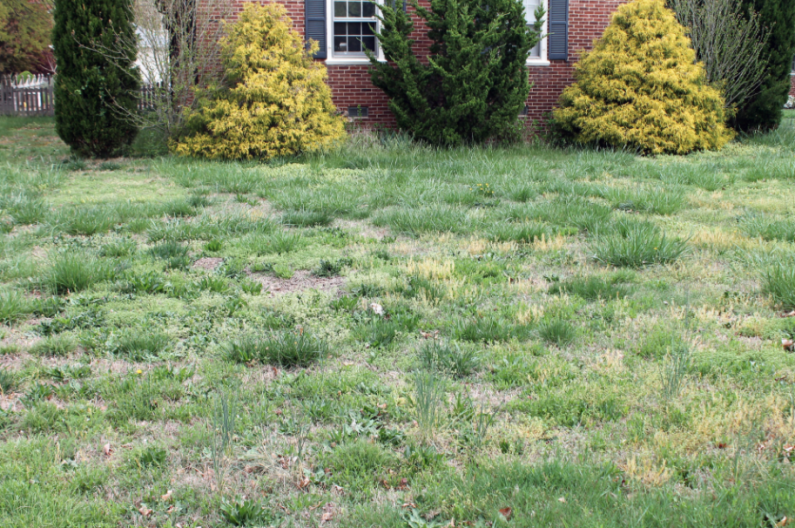
We have a lovely climate in New Zealand, perfect growing conditions from some undesirable species in our lawns. As lawn care specialists we are asked almost daily about weeds - how to spot them, why they’re a problem and what to do about them. To help you identify weeds on your lawn, here are the five most common ones we encounter on a regular basis.
Poa
Its botanical name is poa annua but you might also know it as winter grass, annual bluegrass, annual meadow grass or simply poa. It is possibly the most common and troublesome weed and people don’t like because it is temperamental, dying off easily leaving ugly brown spots. It is also quite susceptible to disease and can require regular fungicide treatment.
Poa is light green in colour with soft leaves that often have a crinkly part. Because it is a grass itself it can at sometimes blend in and not be noticed at first. As it grows you will easily spot its lighter coloured scruffy tufts and white seed heads making your lawn look patchy.
Because poa produces seeds soon after germinating, new seedlings can establish quickly and at any time of year (except when it’s really dry), even if you’re mowing often. It can be quite prevalent on newly established lawns where competition from other grasses is slim. Prevention is the key to stop poa from invading, as few herbicides will control this weed selectively. A strong, healthy lawn and well-rounded lawn care program will help to eventually eliminate it from your lawn.
Moss
Moss is a shallow-rooted weed that covers the ground and can be identified on your lawn as a spongy mat of low-growing greenery. Mosses don’t have true leaves, stems or roots and are rather simple plants with tissues that absorb moisture and nutrients. Although it can survive drought, moss needs moisture to grow so it is usually found where in shady spots drainage isn’t great, and/or there are low nutrient levels and acidic soil.
Moss is not terribly invasive but it is still an issue because it smothers your grass and sucks up all the goodness from the soil. During spring and summer, it can also heat up and die off leaving bare patches. It grows most actively in late autumn and winter and spreads by a variety of methods, most commonly by producing spores that can be dispersed by wind, water or animal and human traffic. Moss can be sorted out short term by spraying, but if the issue is poor drainage or compacted soil, it would be wise to try and rectify this for long-term results.
Clover
White clover (botanical name, trifolium repens) is one of the most common weeds in lawns in New Zealand because its seeds can remain viable in the soil for a long time. Interestingly, it is actually a legume, which is why it’s an excellent source of feed for livestock and can be found on a lot of farms. It is unwelcome on lawns however because it can be slippery when wet, it is a rather aggressive grower and can quickly take over, and its white flowers attract bees and increase the risk being stung.
White clover is easily recognised. The leaves are made up of three leaflets (unless you’re lucky enough to find the legendary four-leafed one) with white markings on them and white flowers. Selective herbicides will control this weed so talk to us to for the correct and effective solution.
Onehunga weed
Also known simply as ‘prickles’, Onehunga weed is a small spindly type weed that can be hard to spot
amongst the grass. But you will certainly feel it underfoot come summer! It spends most of the summer as a dormant seed, germinates in autumn and produces its ‘fruits’ throughout winter. When it reaches the end of its lifecycle the following summer the plant dies off and dries out leaving behind the ‘fruits’, the painful, nasty spikes we know as prickles. Onehunga weed can be sprayed but you need to get the timing just right for an effective outcome.
Broadleaf
Broadleaf weeds are a subset of plants that grow within your lawn that have wide flat leaves. Broadleaf
weeds commonly found in New Zealand lawns include catsear, dandelion, thistles, dichondra, chickweed, creeping oxalis, docks, daisy, fat-hen, pearlwort, speedwells and hydrocotlye. Clover and Onehunga weeds are also considered broadleaf weeds. Some selective herbicides will kill broadleaf weeds without harming surrounding grasses. Some of these weeds look similar to each other but are quite different in how they respond to chemical control. The correct identification of the weed is the first step so we suggest you get in touch with our experts.
Getting it sorted
Most common weeds can be treated with sprays, but the best solution varies depending on the type and ages of your lawn and variety of weeds and grasses present. During summer it can be very difficult to spray as rain is often needed to ensure the correct plants are taking up the correct dosage of the correct treatment. To gain total weed control and enjoy a healthy, lush lawn, talk to us.
We are qualified specialists in this area and have the skills and expertise to help you confirm your initial diagnosis and treat it with prescription-grade herbicides.
